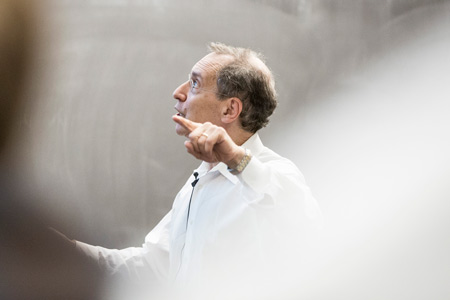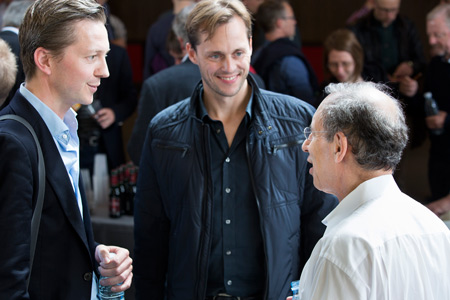How often do we find that the author of more than 1,300 scientific articles is also the co-founder of a long list of companies? The answer is ‘never, unless of course we are talking about Robert S. Langer’.
The professor at MIT (Massachusetts Institute of Technology) invented the world’s first system for controlled release of macromolecules in the body. More specifically, he encapsulated an active anti-cancer substance within a polymer structure which protected the substance from being broken down by the body’s immune system. The idea was described in an article in the scientific journal Nature back in 1976.
“The article met with a somewhat lukewarm response. People apparently found it hard to believe that you could pass through cell walls like a ghost in this way,” recalls Robert P. Langer with a smile.
Drug delivery
In this context, passing through walls is a metaphor for the central challenge in drug delivery. Drug delivery is all about ensuring that the active substance in the medicine gains access to the right place in the body at the right time. This often requires that the substance pass through the skin, the blood-brain barrier, the intestinal walls, the lung wall, or other barriers in the body. In a sense, one might say that Robert S. Langer has had to climb over several walls himself. In the course of his career and concurrently with his research, he has co-founded 27 companies, which has helped him to take his ideas from the research stage through to actual production.
“I founded my first company in 1987 because I realized that this was an effective way to ensure that the research was actually used to improve people’s lives.”
 |
|
Robert S. Langer is one of the world's leading researchers in drug delivery. And as co-founder of 27 companies, he is also an experienced biotech entrepreneur.
|
‘Many stumbling blocks along the way’
Uncharacteristically for a chemical engineer, Robert S. Langer collaborated with doctors at Boston Children’s Hospital. The aim was to produce a substance that could block the formation of new blood vessels. A cancer tumour needs new blood vessels to grow, and the doctors therefore felt that blocking blood vessel formation might prove an effective treatment in certain forms of cancer.
The team succeeded in identifying a suitable substance only to encounter the next problem—namely a large molecule known as a macromolecule—which under normal circumstances would be broken down quickly in the body. Langer’s idea was to encapsulate the molecule in a polymer structure that could be implanted into the tumour itself. The active substance could then be released slowly into the body.
"I realized that I had to become personally involved in the commercialization process if my inventions were ever to benefit society."
Robert S. Langer
The method is standard practice today, but the road from idea to practical application was anything but straightforward.
“Joking apart, my biggest advantage was probably the fact that I hadn’t read the scientific literature that said it couldn’t be done. Gradually, I succeeded in publishing my idea in respected scientific journals, but my ideas didn’t generate the interest from industry I had hoped for.”
The next step, therefore, was to take out a patent in the hope that it would increase the level of interest from investors and pharmaceutical companies. The patent process took more than seven years, but Robert S. Langer finally received his first patent.
When a major company acquired the license to exploit the patent for the treatment of humans and another large company acquired similar rights for the treatment of animals, it seemed as if his plan had worked. However, it was not long before both companies discontinued their projects. That really put things on hold.
“It taught me an important lesson, namely that I had to become personally involved in the commercialization process if my inventions were ever to benefit society.”
However, this proved to be easier said than done.
“There are always many stumbling blocks on the road to starting a new business. But I also had to fight because it was very important for me to continue my academic research.”
Creating an entrepreneurial spirit
The interview is taking place in connection with Robert S. Langer’s H.C. Ørsted lecture at DTU. Characteristic for him, he is also using the visit as an opportunity to hold discussions with DTU and the Novo Nordisk Foundation on possible cooperation with his Langer Lab.
Langer believes that the technical universities have an important role to play.
“It all starts with establishing a scientific edge. You can then go on to create an entrepreneurial spirit. Once the first young generation of entrepreneurs begins to succeed, they will quickly become role models for the next. MIT and Stanford University have used the recipe to great advantage, and it is also my impression that DTU is doing a good job.”

|
|
The interview for Dynamo took place in June 2015 in connection with Langer’s H. C. Ørsted lecture at DTU. Here, fellow researchers and students had the opportunity to meet one of the world’s top researchers and entrepreneurs within drug delivery.
|
Partner with existing businesses
According to Robert S. Langer, the most important prerequisite for a successful entrepreneurship is access to funding:
“Biotechnology is an extremely costly affair. Many excellent projects have faltered simply because the founders couldn’t raise the funds to cover the costs of the initial company start-up phase.”
Langer’s advice is to always seek financing from several different sources, as well as partnering with a pharmaceutical company, for example.
“There’s a limit to how far you can go with drug delivery alone. Only when your invention is combined with medical products do things begin moving forward, both economically and in relation to benefiting public health. Partnerships are thus a win-win situation.”
The same is true of venture capital.
“Venture companies can be extremely useful for a newly established company in helping to recruit the right management and in taking several other strategic business decisions.”
Patents are key
“There are people who think that patents limit the application of an invention, but in my opinion this is rarely the case. Usually, you need a patent to attract financing for the early research and development phase, which is nearly always where the scientific discoveries occur.”
According to the MIT professor, the recipe is just as relevant today as it was when he founded his first company:
“I have maintained this approach to establishing companies over several decades, even though there has definitely been fluctuating investor interest. In fact, I’m convinced that today it is even more important to have a solid basis for the three Ps (see the fact box: ‘Robert S. Langer’s Guide’ at the bottom of the page, ed.). The body of ideas seeking funding is very substantial—which is why it takes something special for a good idea to stand out from the crowd.”
A pill a year
Drug delivery has become ‘big business’. Robert S. Langer estimates that global revenue from drug delivery is somewhere between USD 100bn and 200bn. “40 years ago the figure was zero.”
Nevertheless, there is still room for significant growth, he notes, pointing to several future growth areas.
“Currently there are some very exciting research developments in the field of genetic treatment such as mRNA- or rRNA-based products, which can activate or deactivate genes linked to specific diseases. Here, however, we mustn’t underestimate the challenges of drug delivery. We are going to need a completely new class of drug delivery systems to get this type of medicine to the correct location in the body.”
“We are also seeing many interesting ideas for new, extremely targeted nanomedicine. The field is ordinarily considered as nanotechnology, but it could equally be called drug delivery, as it is usually just the delivery method that is the key to the drug’s effect.”
“I’m also convinced that we will see new types of vaccines made possible through new drug delivery methods.”
While new horizons are being explored, there is plenty of room for improvement in what can already be considered traditional drug delivery:
“For example, there are a number of medications which we previously thought could only be administered by means of injection which could now be given in pill form. This benefits not only the patient, but offers a cheaper means of administering the medicine. Personally, I am also very interested in the potential for not just providing the medication in pill form, but also of administering it in such a way as to extend its effect. In time, it may be possible to take a pill every few weeks—or maybe every few years even.”
Edited article from DYNAMO no. 42, DTU’s quarterly magazine in Danish.

Robert S. Langer is a chemical engineer and a professor at MIT (Massachusetts Institute of Technology).
He is also considered a pioneer in the field of drug delivery, having developed the world’s first system for controlled release of macromolecules into the body.
In addition, he has penned more than 1,300 scientific articles and is co-founder of 27 biotech companies. Langer has also taken out numerous patents which form the basis for license agreements with more than 300 companies within medicine, chemistry, biotechnology and medical technology.